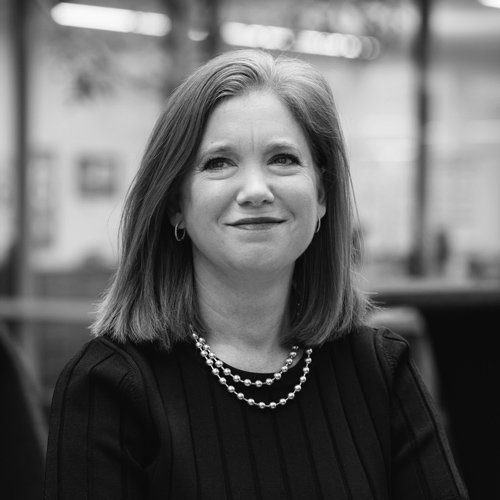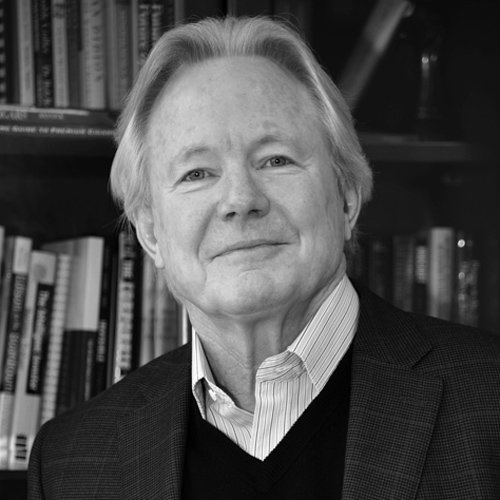Bjarne Tellmann had already acted in Norwegian films and a Swedish television show when he experienced a transformational moment in his career path.
In Los Angeles, where the Oslo native was taking a gap year from an acting conservatory, an episode of L.A. Law prompted his revelation. He soon earned a law degree from the University of Chicago and spent twenty years leading international teams at several law firms and Coca-Cola. Now Tellmann is transforming his legal department at Pearson, where change is written in the company’s DNA.
Pearson emerged in Victorian England as one of the world’s largest construction companies. In subsequent years, it transformed into a truly diversified holding company. At one point, Pearson owned the Madame Tussauds wax museum, French winery Château Latour, Sky TV, Penguin Books, the Financial Times, and a 50 percent share of The Economist.
“In recent years, Pearson has become much more focused on educational publishing,” Tellmann says. As a result, Pearson sold these non-core assets to streamline its identity in the twenty-first century.
Tellmann joined the company in April 2014 as senior vice president and general counsel. With Pearson’s new vision concentrated entirely on education, Tellmann arrived with a mandate to unify disparate teams in order to move forward Pearson’s unique mission: to help people make progress through access to better learning.
“There are 250 million children around the world who are coming out of elementary school unable to read or write,” Tellmann says. “There are half a billion young adults who are out of work while
40 percent of employers are not able to find qualified candidates to fill open positions. Pearson plays an active role in helping to try and tackle these pressing global challenges.”
One of the ways Pearson does this is by providing increasingly sophisticated, personalized learning. The typical classroom structure has remained unchanged for centuries—rows of desks and a blackboard—yet Tellmann explains that Pearson’s investment in adaptive technology looks to evolve this setting.
“We’re asking, ‘How do we not only digitize textbooks, but also make those textbooks come alive?’ Digital learning can help increase access to education and improve learning outcomes. Personalized learning will help students stay engaged, deepen learning, and help teachers be even more effective in reaching their students. It’s incredibly exciting to me,” Tellmann says.
When put against this backdrop, Pearson needed to reorganize in order to help it focus on fewer, bigger opportunities in education. Its legal leader put his effective change management skills
to use.
Tellmann combined six separate legal departments, each with its own culture and structure that reported to different business units, into one legal department. Yet his task remains ongoing as he continues to optimize his global legal team (now comprising about 170 individuals across six continents) to boost Pearson’s innovative mission.
In response to the need for other legal leaders to develop similar, high-performance teams worldwide, Tellmann created a strategic road map for contemporary general counsel. In his recently released book, Building an Outstanding Legal Team, Tellmann outlines the systems and philosophies that have proven successful at Pearson.
“We live in a world with exponential change that impacts our professions,” Tellmann says. “This book provides a model to help general counsel build outstanding legal teams and accelerate their development. General counsel have to become their own chief executives in many ways. They have to learn how to communicate, build cultures, and anticipate change—all in addition to being top-notch lawyers.”
The framework of his approach consists of two classifications. One is what Tellmann refers to as “the hardware,” or the structural elements such as talent, partnerships, and budget.
“I focus on the hardware first because that gives you the credibility to change the harder stuff,” he says, adding that the “harder stuff” is changing the culture and people, which he categorizes as “the software.” In his book, Tellmann also demonstrates how to connect the two processes through leadership best practices.
THE HARDWARE
Unification of Pearson’s fragmented legal department began three years ago, and Tellmann’s first step was to challenge its very existence.
“I spent a lot of time asking people, ‘What is it that you do that is unique?’ Why shouldn’t we all just go directly to outside counsel?’” Tellmann says.
The legal team recognized its ability to be proactive (identifying issues before they become problems) and pragmatic (creating tailored solutions based on inside knowledge of the business and legal expertise). Tellmann took a closer look at core risks before turning to policies, technology, organization, and the budget. Then, he began a transformation to better support the legal team’s newly established identity.
Pearson lacked billing and gatekeeper policies, which translated to paying outside firms top rates and unnecessary overhead costs. The year before Tellmann arrived, the company paid nearly a quarter of a million dollars in photocopies and nearly $50,000 in stamps, which he says is not the case anymore.
Instead, he implemented a professional panel selection process that evaluated and hired outside firms as well as alternative providers such as Axiom to help broaden the supplier base.
“Now we’ve got the right firms in the right place doing the right types of work,” he says. “We’ve reduced our rates significantly.”
Tellmann then turned his attention to the technology, or lack thereof.
“We didn’t have modern management systems or any core technology that supported routine work,” he says. “The result was we didn’t know what we were spending or how we were spending our time, and we weren’t able to collaborate with each other.”
To upgrade the department, he rolled out five technologies in twelve months: e-signature tools, a conflict management system, data management tools, IP tracking tools, and an e-billing system.
Tellmann also took part in reviewing the legal department’s internal/external spend ratio each year.
“We were spending about 60 percent of our post-spend externally, and I decided that if we move that toward 60 percent internal, total cost would come down,” he says.
Consequently, the team framework also changed based on Pearson’s core legal risks identified in a comprehensive review—requiring layoffs of about 10 percent of the team last year to improve efficiency. Tellmann brought in specialists who are now accountable for covering each risk area and team members that are generalized as
business partners.
“As a result of all that restructuring on ‘the hardware’ side, I’m proud to say we’ve reduced our controllable costs by 40 percent since 2014,” Tellmann says. “It gives us the credibility to say, ‘Alright, now let’s look at our culture.’”
THE SOFTWARE
Tellmann is changing “the software” of his team, aiming to develop a legal subculture based on global connectivity in support of Pearson. “It’s been a big journey,” he says.
Despite it being almost impossible—and not desirable—to erase a legacy culture, Tellmann says it is possible to influence it.
“I think of that like a bonsai tree. You can’t chop down the trunk and plant a new one—that will take two hundred years,” he explains. “But you can trim the branches to grow it in a certain way. That’s what I would call ‘hacking your culture.’”
A hacker is constantly probing to find vulnerabilities and trying to find a way in, which is how Tellmann describes this next phase of cultural development. The large-scale hack he’s rolling out now is called “project road map.”
“The idea is to bring people from all across the legal team from all over the world, from Australia to San Antonio, into one room and ask them to challenge the underlying assumptions on which our culture rests,” he says, adding that these discussions lead to a deeper understanding of how different nationalities deal with conflict or how they
approach reasoning.
As the son of a diplomat, it seems fitting that Tellmann is creating an optimal legal environment through several cross-cultural initiatives. Rotational assignments give team members exposure that might be transformative and connect people across borders. Global practice groups study core risk areas, such as data privacy, to become experts as they collaborate across continents. He also tests his department with thought exercises, asking how the legal team applied Pearson’s core values—brave, imaginative, decent, and accountable—during the last three crises that the
team resolved.
The catalyst program selects five to six high-potential people around the world for a team focused on a particular legal project. The catalyst team collaborates for three to six months under the sponsorship of a senior leader, then team members fly in to present their solutions to members of the leadership team.
“It’s a cool way to create connectivity, build our pipeline, and see what characteristics do well in this environment to cultivate in the team,” Tellmann says.
HOW DO YOU LEAD?
In addition to legal expertise and strong business sense, there are a variety of key qualities that Tellmann nominates as essential to his legal team and its leaders—qualities also in line with Pearson’s mission to help people make progress through access to better learning. For example, the general counsel seeks
information herbivores.
“They’re future-literate, constantly grazing on new ideas and new information,” he explains, citing an innate curiosity, and adding that he also prioritizes excellent communication skills. “Ultimately, our job is to persuade. It requires an ability to focus on the why and how of what we’re doing and understanding the power of storytelling.”
Tellmann also requires a dedication to service in regard to servant leadership.
“If you manage a team, you are there to serve your team,” he says. “You don’t serve them by giving them everything they want, but you have their best interests at heart. You’re trying to develop and nurture them to help them soar.”
The legal department holds individuals accountable for identifying career opportunities, taking the initiative to develop client relationships, resolving matters, and being active co-creators of
the culture.
“You can have power that derives from your expertise or your title,” Tellmann says. “But the power I want to see is the personal power that derives from who you are—your ability to ask questions, connect with people, and provide
safe environments.”
Lawyers have a tendency to be risk-averse, or advisers rather than deciders, Tellmann explains, but he replaces the myopic with action-oriented lawyers when honing his team. And for Tellmann, that means, while talent and intelligence are good, grit is even better.
“Imagine a single mom who put herself through law school and raised two kids while doing it,” he says. “To me, that’s impressive. I know that person will steer through a crisis in the right way . . . somebody who has stood up to serious adversity and overcome it.”
The biggest challenge of “the hardware” and “the software” is that the journey never ends, Tellmann says. But these strategic steps keep his legal department aligned with Pearson’s ascent in the education world. To evolve alongside this innovative new chapter of the business, Tellmann embodies how general counsel must become their own chief executives by actively developing a unified global culture.


